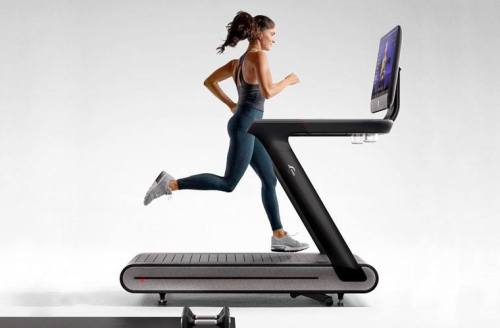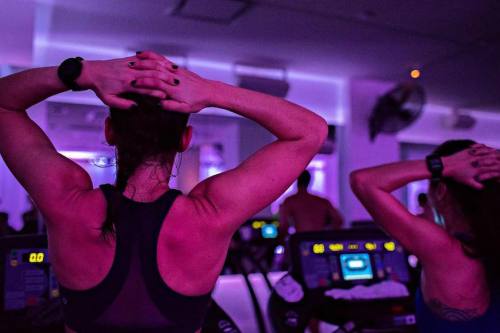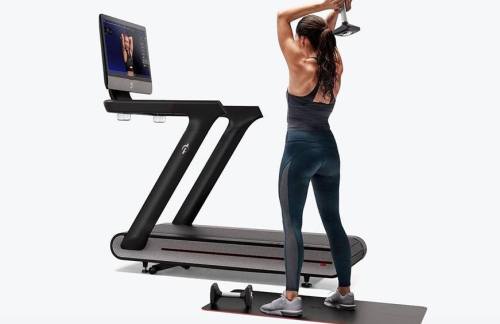Fit-tech startup Peloton is already dominating the fitness game with its tricked-out indoor spin bike and a $1.25 billion valuation. Recently, at its Home Rider Invasion weekend, the company’s co-founder and CEO John Foley said they sell a bike a day in all 50 states, and last month there were over 2.5 million rides taken. Now, it’s hoping to replicate that success with its new $4,000 treadmill—AKA the Peloton Tread.
At nearly twice the price of its bikes, it’s easy to second guess their goal. But before you do, it’s worth comparison shopping: There is a market for high-end home treadmills. And models such as the Woodway or the Technogym range from $6,000–$15,000 (which doesn’t include instructor access or unlimited classes). From that perspective, Peloton’s actually positioned itself to be more than competitive in the category when the Tread becomes available in September. (You can reserve yours, which will be delivered on a first come, first served basis.)
In the meantime, the company opened its first Tread studio full of the machines in New York City earlier this month. As someone who loves to run—and a big Mile High Run Club fan (up until now the only treadmill class in the game), I was very curious to give it a test, ahem, run.
Below, I reveal all, from the Tread’s features, to the class structure, and how it compares to Mile High and other boutique fitness classes. If you’re considering the investment—or are just shamelessly curious—here’s what you need to know.
Keep reading to find out what taking a Peloton Tread class is really like.

What makes Peloton Tread different from other treadmills
So, what does $4,000 get you? Similar to the bike, the Tread has a high-quality HD screen—the virtual portal to live and pre-recorded classes. At 32-inches, it’s actually bigger than the bike’s. Below the display is a full-length tray (perfect for putting your phone or towel) and a water bottle holder on each side. And under your feet is a shock-absorbing slat belt that feels forgiving, whether you’re wearing foam sneakers or not.
On either side of the powder-coated carbon steel rails is a red dial—the left to control incline and on the right to control speed. Those outdated numbered buttons are nowhere to be seen. Instead, you just lightly roll the dial to increase (or decrease) your settings. Or, you can jump a full point by pressing it. (The machine goes up to a 12.5 mph and a 15.0 incline.)
If you already own a Peloton bike, you won’t necessarily have to shell out for the Tread to access its classes. Rolling out this fall, the workouts will be available to stream on your tablet or phone via its app, so you can use your own treadmill and still be part of the workout—or you can stream it to your TV and run along, if it’s in the same room as your treadmill. This cross-training option won’t be available to Tread owners who want to spin, though, sadly.
Okay, so that’s the deets on the machine. Now comes the workout.

How a Peloton Tread class is structured
The new Tread studio has a similar feel to the OG studio: sleek with red and black accents, plus a little boutique stocked with workout gear. Matty Maggiacomo taught my 45 minute class, which was a full-body bootcamp. Through the course of the first 10 minutes, Maggiacomo coached the class through several short intervals, varying the speed and incline. (Soundtrack: lots of Madonna, Debbie Harry, and Whitney Houston.)
Then, he told the class to turn the speed down to zero (but not to “pause” it or turn it off, so the clock was still running and the data was preserved) and the next roughly 20 minutes were spent on the floor, using either a pair of medium weights or one heavy weight. It’s this part of the class that really made it more than just running. “Tread is more than a treadmill. It’s a portal to a full-body workout,” Foley told me the day before. And he’s right—people aren’t just being coached on what to put the speed and incline on; they’re strength training, too.
“Tread is more than a treadmill. It’s a portal to a full-body workout.” — John Foley, Peloton CEO
After the floor work, it was back on the treadmill for a roughly seven-minute run, again varying the speed at different points. In classic Peloton style, the overall mood of the class was light and inspiring—no drill sergeant vibes at all. And it’s effective—I had a smile on my face the entire class—even during an all-out sprint. (Okay, almost the whole class. Some of Maggiacomo’s abs-moves were no joke.)
During the workout, I had no problems with my Tread at all, though when another Well+Good editor went to the very first class for press, her machine malfunctioned—as did half the class’. “We’re still technically in development until the September release,” Foley tells me. It might be similar to a new iPhone release: They tend to work out the bugs a few months in. But in all fairness to the brand, no one in my class at least had a problem with their machine.

How Peloton Tread compares to other boutique fitness classes
While some of the Tread classes will focus more on running, the majority will be a mix of time on and off the treadmill. Because of this set-up, there’s more of a comparison to classes like Orangetheory or Barry’s Bootcamp than Mile High Run Club. (Although even Mile High is getting in on the full-body game with their latest class, The Build.)
What sets a Peloton Tread class apart the most is having the leaderboard. While it’s not really relevant during the floor work, it can be a big motivator during your run (if you want it to be; otherwise, you can hide it like you do on the bike). While several spinning studios have leaderboards, there isn’t a leaderboard for treadmill classes or other bootcamp-style workouts.
I like to run and get quite competitive about it, so I wasn’t surprised that I enjoyed the class so much. Someone who doesn’t like to run might have a totally different opinion of the class than I do. But there’s one thing that isn’t debatable: When Peloton does something, they do it well.
And as for the competition between the Tread studio and similar studios such as Mile High and Barry’s? Well it seems what’s happening on the leaderboard isn’t the only race to watch.
If you’re not fully confident in your treadmill running, these tips will help.
Sign Up for Our Daily Newsletter
Get all the latest in wellness, trends, food, fitness, beauty, and more delivered right to your inbox.
Got it, you've been added to our email list.











